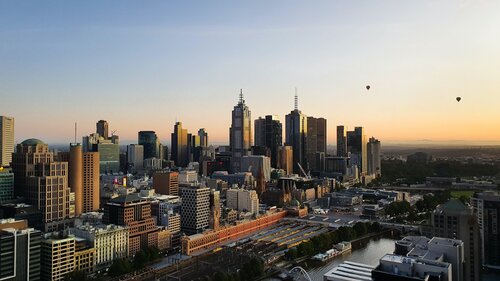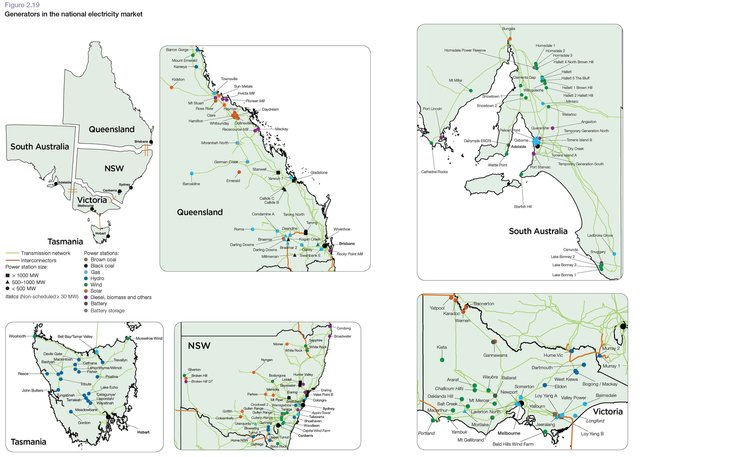



Victoria has a population of over 6.6 million and is the most densely populated state. Over 75% of the population of Victoria lives within the metropolitan area of greater Melbourne.
Victoria generates almost of a third of the state’s total residential demand from solar systems, more than 675,078 homes and businesses have solar systems, and 14,988 have a solar battery too. To harness the sun’s power to heat their homes, 511,212 have installed a solar water heater or air source heat pump, the highest amount of any state in Australia. Victoria has also installed 75 wind turbines to date.
(source – Clean Energy Regulator).
The Australian PV Institute estimates the percentage of dwellings with a PV system to be 24.6%. Therefore there is plenty of scope for lots more renewable energy systems to be installed.
The Victorian Government have set a target of 40% of their electrical needs to come from renewable sources by 2025, 65% by 2030, and 95% by 2035. Victoria will also be home to Australia’s largest wind farm, which will be constructed in the Golden Plains Shire, 60 kilometres north-west of Geelong and have 215 wind turbines, enough clean energy to power 765,000 homes.
Currently, there are 16 large-scale solar farms in operation, with another 86 with approvals, 7 more in the application process, and 4 more under construction. These figures demonstrate how committed Victoria is to the renewable future world.
(source – Victoria State Government – energy, environment and climate action)
The number of solar systems installed grows each day, as more households realise the benefits that such a system has on their power bills and the environment. Don’t let renewable energy savings pass you by any longer, take action today to see what benefits a renewable energy system could have on your bills and the positive impact on the environment.
Victoria’s Electricity Grid

Victoria is part of the National Electricity Market (NEM) and they have AusNet services as the high voltage transmission network service provider. AusNet is a publicly listed company that is owned by Singapore Power (31%), State Grid Corporation of China (19.9%) and publicly traded (49%).
You can sign up with a choice of retailers, either on a standard or market retail contract. To find an energy plan that meets your needs, Victoria Energy Compare is a great site by the Australian Government and can be accessed here.
Please ensure you shop around to get the best deal, and make sure you consider the Feed-in Tariff (FITS) when looking at your energy provider, when you choose a renewable energy system for your needs, you want to get paid for the excess power your system produces.
Rebates and Incentives
Government Incentive – Small-scale Technology Certificates (STC)
When you install a renewable energy solution, you are entitled to claim Small-scale Technology Certificates (STCs) against the cost of the system. An STC is equal to 1 megawatt-hour of renewable electricity, either generated or displaced by eligible small-scale renewable energy systems such as solar PV, wind, hydro, solar water heaters and air source heat pumps.
The STCs are part of the Australian government’s Renewable Energy Target. STCs fluctuate a little in the marketplace and are generally always claimed on the customer’s behalf by the retailer installing your system.
You can claim them yourself via the REC Registry, however, it is much easier to allow your trusted and endorsed installer to claim them on your behalf. At the time of writing this, STCs are trading at $40 each, however, they have been as low as $16 per STC.
To see an up-to-date price please click here. At $40 per STC, this means for a 5kw inverter with 6.6kw of panels one can expect a reduction of $ 3,000.
The Clean Energy Regulator provides a free STC Calculator for you to establish how many STCs your renewable energy solution will generate. If you would like to see what your STC rebate would be with a ‘live’ price right now!
Greenbank Environmental can provide this here.
Feed-in tariffs (FITS)
Within Victoria, you will be eligible for a payment for any electricity you export back to the grid that you do not consume. This is known as a Feed-in Tariff.
Currently, the Feed-in Tariff can be found in the table below. The FIT is for all energy you export back to the grid, be it from solar panels, wind turbines, batteries or electric vehicles.
Electric Vehicles (EVs)
The Victorian Government is currently offering a subsidy of $3,000 for eligible EVs which have a dutiable value under $68,740. This subsidy is called the Zero Emissions Vehicle (ZEV) subsidy.
Currently, there are 3,239 remaining, out of 20,000 subsidies available. So be quick if you want to get $3,000 off the cost of your EV car.
| Retailer | Min Solar FIT | Max Solar FIT | Conditions | |
|---|---|---|---|---|
| Origin Energy | VIC | 5.2 c | 12.0 c | Only if buy solar through Origin – 10kW max |
| OVO Energy | VIC | 5.2 c | 12.0 c | |
| AGL | VIC | 5.2 c | 12.0 c | System size 10kW max |
| Simply Energy | VIC | 5.2 c | 11.0 c | |
| Sumo | VIC | 5.2 c | 10.2 c | |
| 1st Energy | VIC | 5.2 c | 10.2 c | |
| EnergyAustralia | VIC | 5.4 c | 10.0 c | |
| Energy Locals | VIC | 8.3 c | 8.3 c | |
| Arcline by RACV | VIC | 8.3 c | 8.3 c | |
| Circular Energy | VIC | 7.0 c | 7.0 c | |
| Tango Energy | VIC | 5.2 c | 6.7 c | Must install through Tango and capped at 3.5kWh per day |
| Alinta Energy | VIC | 6.7 c | 6.7 c | System size 5kW max |
| CovaU | VIC | 6.7 c | 6.7 c | |
| Powershop | VIC | 5.2 c | 6.7 c | |
| Momentum Energy | VIC | 6.7 c | 6.7 c | System size 10kW max |
| Red Energy | VIC | 5.2 c | 6.2 c | |
| Dodo | VIC | 5.2 c | 5.2 c | |
| Amber Electric | VIC | 5.2 c | 5.2 c | |
| Lumo Energy | VIC | 5.2 c | 5.2 c | |
| ReAmped Energy | VIC | 5.2 c | 5.2 c | |
| Diamond Energy | VIC | 0.0 c | 5.2 c | |
| GloBird Energy | VIC | 5.2 c | 5.2 c | |
| Indigo Power | VIC | 5.2 c | 5.2 c | |
| Kogan Energy | VIC | 5.2 c | 5.2 c | |
| Nectr | VIC | 5.2 c | 5.2 c |
